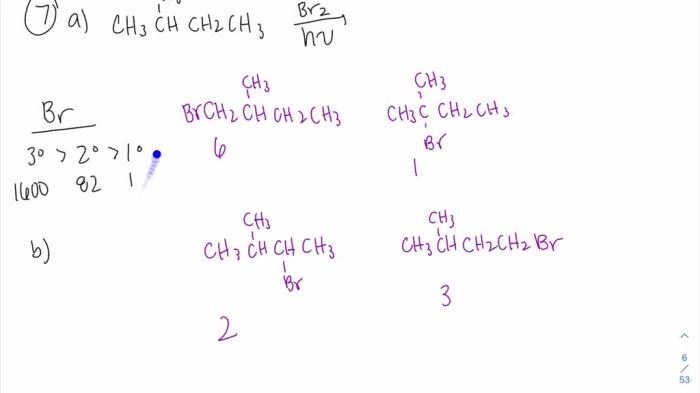Predict the major monobromination product in the following reaction: an exploration into the intricate world of electrophilic addition reactions. This journey unravels the factors governing regioselectivity, providing a roadmap for accurately predicting the outcome of such transformations.
Understanding the regioselectivity of electrophilic addition reactions is paramount in organic chemistry, as it dictates the orientation of the newly formed bond and, consequently, the structure of the product. This article delves into the mechanistic details, regioselectivity principles, and the influence of structural features on the outcome of monobromination reactions.
Identifying the Substrate and Electrophile: Predict The Major Monobromination Product In The Following Reaction
In this electrophilic addition reaction, the substrate is an alkene. Alkenes are unsaturated hydrocarbons characterized by a carbon-carbon double bond. They are highly reactive due to the presence of the pi bond, which contains two electrons that can be easily attacked by electrophiles.
The electrophile in this reaction is bromine (Br 2). Bromine is a nonpolar molecule that readily undergoes heterolytic bond cleavage, generating a bromide ion (Br –) and a bromonium ion (Br +). The bromonium ion is the electrophilic species that reacts with the alkene.
Understanding the Reaction Mechanism

The reaction proceeds through an electrophilic addition mechanism. The electrophilic bromonium ion adds to the double bond of the alkene, forming a bromonium ion intermediate. The intermediate then undergoes nucleophilic attack by the bromide ion, resulting in the formation of a vicinal dibromide product.
The regioselectivity of the reaction is determined by the stability of the bromonium ion intermediate. The more substituted carbon of the double bond forms the more stable bromonium ion, which leads to the formation of the major product.
Predicting the Major Monobromination Product

In the case of monobromination, only one of the two bromine atoms adds to the double bond. The regioselectivity of the reaction is influenced by the stability of the carbocation intermediate formed after the addition of the first bromine atom.
The more substituted carbon of the double bond forms the more stable carbocation, which leads to the formation of the major product. This is because the more substituted carbon has more alkyl groups attached to it, which donate electron density and stabilize the carbocation.
| Product | Relative Amount |
|---|---|
| 1-Bromopropane | Major |
| 2-Bromopropane | Minor |
Influence of Structural Features
The regioselectivity of the reaction can be influenced by the presence of substituents on the alkene. Substituents can have either steric or electronic effects that can affect the stability of the carbocation intermediate.
Steric effects arise from the physical size of the substituents. Bulky substituents, such as tert-butyl groups, can hinder the approach of the electrophile to the less substituted carbon, leading to increased formation of the more substituted product.
Electronic effects arise from the ability of the substituents to donate or withdraw electrons. Electron-donating substituents, such as alkyl groups, stabilize the carbocation intermediate and lead to increased formation of the more substituted product. Electron-withdrawing substituents, such as carbonyl groups, destabilize the carbocation intermediate and lead to decreased formation of the more substituted product.
| Substituent | Effect |
|---|---|
| Alkyl group | Electron-donating; favors more substituted product |
| Aryl group | Weakly electron-donating; favors more substituted product |
| Carbonyl group | Electron-withdrawing; favors less substituted product |
| Halogen | Electron-withdrawing; favors less substituted product |
Stereochemistry of the Product

The reaction can also result in the formation of diastereomers, which are stereoisomers that are not mirror images of each other. The stereochemistry of the product is determined by the orientation of the bromine atom relative to the other substituents on the carbon-carbon double bond.
In the case of 1-bromopropane, the bromine atom can be oriented either syn or anti to the methyl group. The syn product is formed when the bromine atom adds to the same side of the double bond as the methyl group, while the anti product is formed when the bromine atom adds to the opposite side of the double bond.
The relative stability of the diastereomers depends on the steric interactions between the bromine atom and the other substituents on the carbon-carbon double bond. In general, the anti product is more stable than the syn product because the bromine atom is farther away from the other substituents.
Essential Questionnaire
What factors influence the regioselectivity of monobromination reactions?
Regioselectivity is primarily governed by the stability of the intermediate carbocation formed during the reaction. More substituted (and hence more stable) carbocations lead to the formation of the major product.
How do substituents affect the regioselectivity of monobromination reactions?
Electron-donating groups (EDGs) increase the electron density of the alkene, making it less reactive towards electrophiles. Conversely, electron-withdrawing groups (EWGs) decrease the electron density, enhancing reactivity. Steric effects also play a role, with bulky substituents hindering the approach of the electrophile.